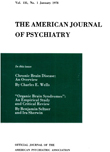Abstract
A bromide psychosis is one which starts during bromide intoxication and clears up fairly soon—usually several weeks, though sometimes longer—after discontinuance of the drug. Four varieties of bromide psychosis are known:
1. Simple intoxication, marked by dullness and mental sluggishness, with good orientation, and without delusions or hallucinations.
2. Delirium, marked by disorientation, thinking disturbances, mood disturbances (usually fear), delusions, hallucinations and other symptoms.
The first two varieties are well known; the next two are not.
3. Hallucinosis, which differs from delirium in that orientation is intact.
4. Schizophrenia, a psychosis of predominantly paranoid coloring which, to the examiner who does not know the history and laboratory findings and has not yet seen the outcome, has all the earmarks of an "ordinary" paranoid schizophrenia, from which it differs only in that it is a transient psychosis which has supervened during bromide intoxication.
Sometimes a bromide schizophrenia is accompanied by disorientation, a symptom which does not belong to the schizophrenic picture. In such cases it is believed that the bromide schizophrenia came first, and that delirium ensued subsequently because the drug was not stopped. Such cases are to be distinguished from those "ordinary" schizophrenics who, because of pre-existing psychotic symptoms, start taking bromide and take it long enough to become delirious. Anyone who takes enough bromide may become delirious, and there is nothing remarkable when this happens to an ordinary schizophrenic. It is quite different with the patient who was not manifestly schizophrenic until bromide made her so.
Bromide schizophrenia differs from bromide delirium and hallucinosis in the following respects (leaving aside for a moment the basic difference between delirium and other psychoses in respect to orientation):
1. Bromide schizophrenia occurs by preference in persons with strong schizoid leanings, while delirium and hallucinosis show no such preference.
2. The characteristic schizophrenic disturbance of rapport is not found in delirium and hallucinosis.
3. The content of the schizophrenia, as in any ordinary schizophrenia, has a flavor of the bizarre: ideas of influence and mind-reading, ideas of electricity and somatic distortions are apt to be prominent.
4. In schizophrenia the patient's delusions and hallucinations are marked by heightened self-reference, which is not the case to the same degree in delirium and hallucinosis.
It is concluded that bromide intoxication has the power to bring to the surface a latent schizophrenia, which, when favorable conditions have been restored, may once again go into hiding. In this respect bromide intoxication resembles many other intoxications.
It is wise to examine the serum for bromide routinely in every acute psychosis, rather than to do so only "when indicated." If the test is not made routinely, one will overlook some cases, for sometimes one does not suspect a bromide psychosis until an unexpected recovery has opened one's eyes, at which point it may be too late to verify the diagnosis chemically.

